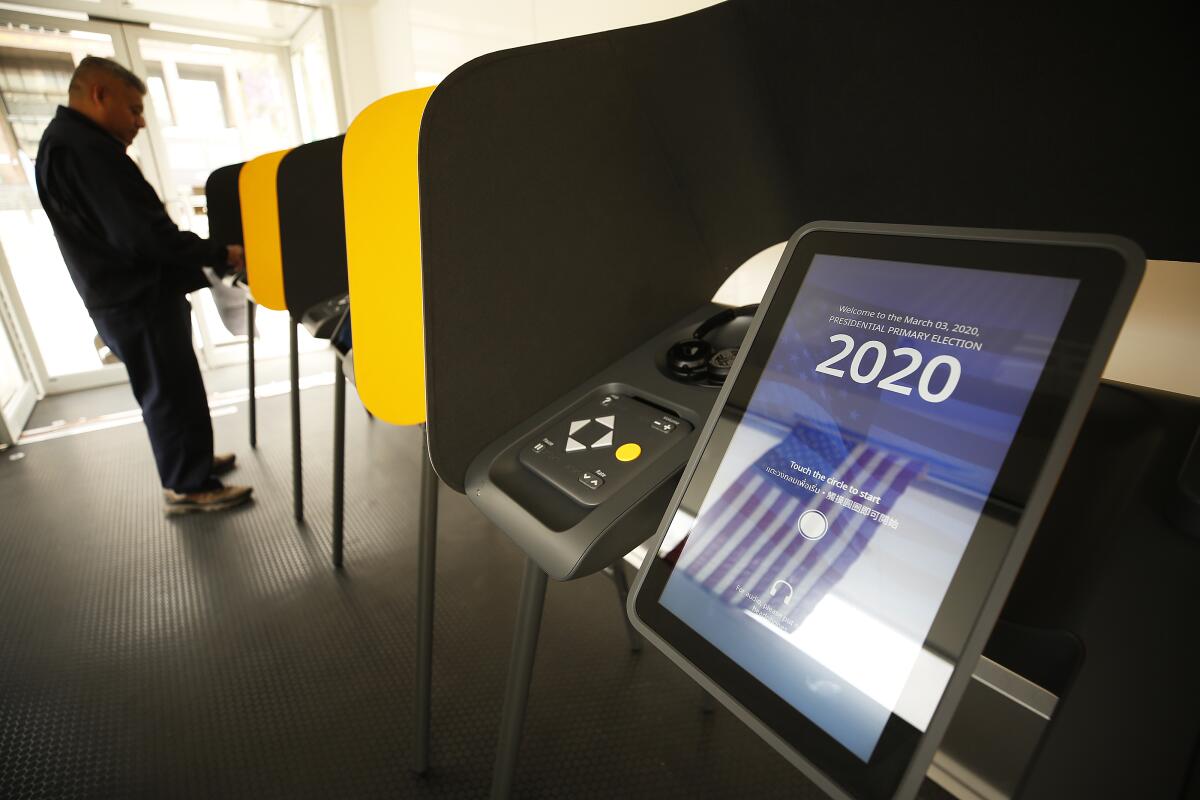Long lines are possible for L.A. voters who wait until election day

- Share via
For all of the excitement surrounding almost two weeks of early voting in Los Angeles, an opportunity made possible by the county’s embrace of a new state election law, hundreds of thousands of voters — if they choose to vote at all — will now have to do it the old-fashioned way on Tuesday.
Elections officials report 248,834 voters cast ballots at regional vote centers in the 10 days leading up to California’s presidential primary. But as many as 1.7 million Angelenos who are registered to vote but did not receive an absentee ballot had not shown up by the time most centers closed on Monday. They will need to find one of the locations on election day, increasing the likelihood of long lines in the hours before polls across the state close at 8 p.m.
“I think we’re going to see a lot of activity on Tuesday,” said Dean Logan, registrar of voters for Los Angeles County. “But it’s hard to predict turnout in an election like this.”
That a political traffic jam might arise in L.A. was not totally unexpected.
Two significant changes arrived in L.A. in time for the statewide primary: a new $300-million voting system that relies on touch-screen machines to mark paper ballots, unique to the county and designed over the last decade, and the implementation in L.A. of a state election law that swaps out neighborhood polling places for multipurpose vote centers.
Omega Hsu, who lives in Los Feliz, said the first thing she noticed when she went to vote at the local Masonic Lodge was the line. There were about 15 to 20 people ahead of her when she arrived — a stunning backlog, she thought, for 11:30 a.m. on Monday.
“I mean, what’s going to happen tomorrow?” said Hsu, 59. “People are just going to walk away, I think.”
She said a poll worker told her the long line was due to delays caused by malfunctioning voting machines, touch-screen devices used to make selections and then print paper ballots. Voters review the selections on the paper ballots and reinsert them into the machine, where they are fed into a ballot box.
Hsu said she worried some voters would incorrectly think the paper ballot that came back out for review was a receipt. Other voters reported similar confusion over the weekend.
“I can see how, if you’re not used to it — especially for older voters — it can be very confusing,” she said.
L.A. elections officials said they had redoubled their efforts over the weekend and on Monday to ensure voting center staff members gave clear information about how to vote. Logan said he was “encouraged by the feedback” from many county voters who said they liked the experience. But he also acknowledged other miscues reported by voters, including locations that opened late or not at all.
“L.A. County continues to be a very challenging jurisdiction,” he said. “But with the vote centers being open before election day, now we have a longer on-ramp to address those issues.”
While the vote centers offer more election-related services than the polling places they replaced, there are substantially fewer of them — 978 locations across the county, compared with 4,698 polling places in the 2016 presidential primary. Election officials promised to post signs at former neighborhood polling sites listing the nearest vote center.
One upshot for voters, though, is that they don’t have to visit the one closest to where they live. Because ballots are printed on-site, voters can visit any location in the county.
Sterling Wong, 40, of Monterey Park said he was glad that he could vote at any voting center, rather than wake up early to make it to his assigned voting place and wait in line before work. Wong was able to vote in Long Beach and said his name was pulled up by poll workers in seconds.
“It was super easy,” he said. “It was very easy to read. I just clicked through.”
Not everyone found it so easy.
At the Drake Park vote center in Long Beach, only a few people voted in a 40-minute span. Sergio Hernández Echeverría, 68, struggled to understand volunteers and required help from a translator while checking in. He ultimately decided to leave the center and use his mail-in ballot back at home. Though he wanted to come to the voting center to see how it was, he decided he felt more comfortable voting at home, with the help of his children.
“I don’t know a lot of English. I get nervous,” he said. “It’s easier at home, so I have time to think.”
Other California election rules — new choices offered in addition to those unique to Los Angeles — posed additional challenges. San Pedro resident Ruth Fowler, who said she became a U.S. citizen last week, said she wasn’t told by vote center workers how to participate in the Democratic presidential primary as an unaffiliated, “no party preference” voter. Those voters must ask for a “cross-over” ballot to vote in the Democratic presidential contest.
Fowler said the special ballot wasn’t offered “and I didn’t know how to ask for one.”
“I have never voted in such a complicated election in my life,” she said.
More to Read
Sign up for Essential California
The most important California stories and recommendations in your inbox every morning.
You may occasionally receive promotional content from the Los Angeles Times.













